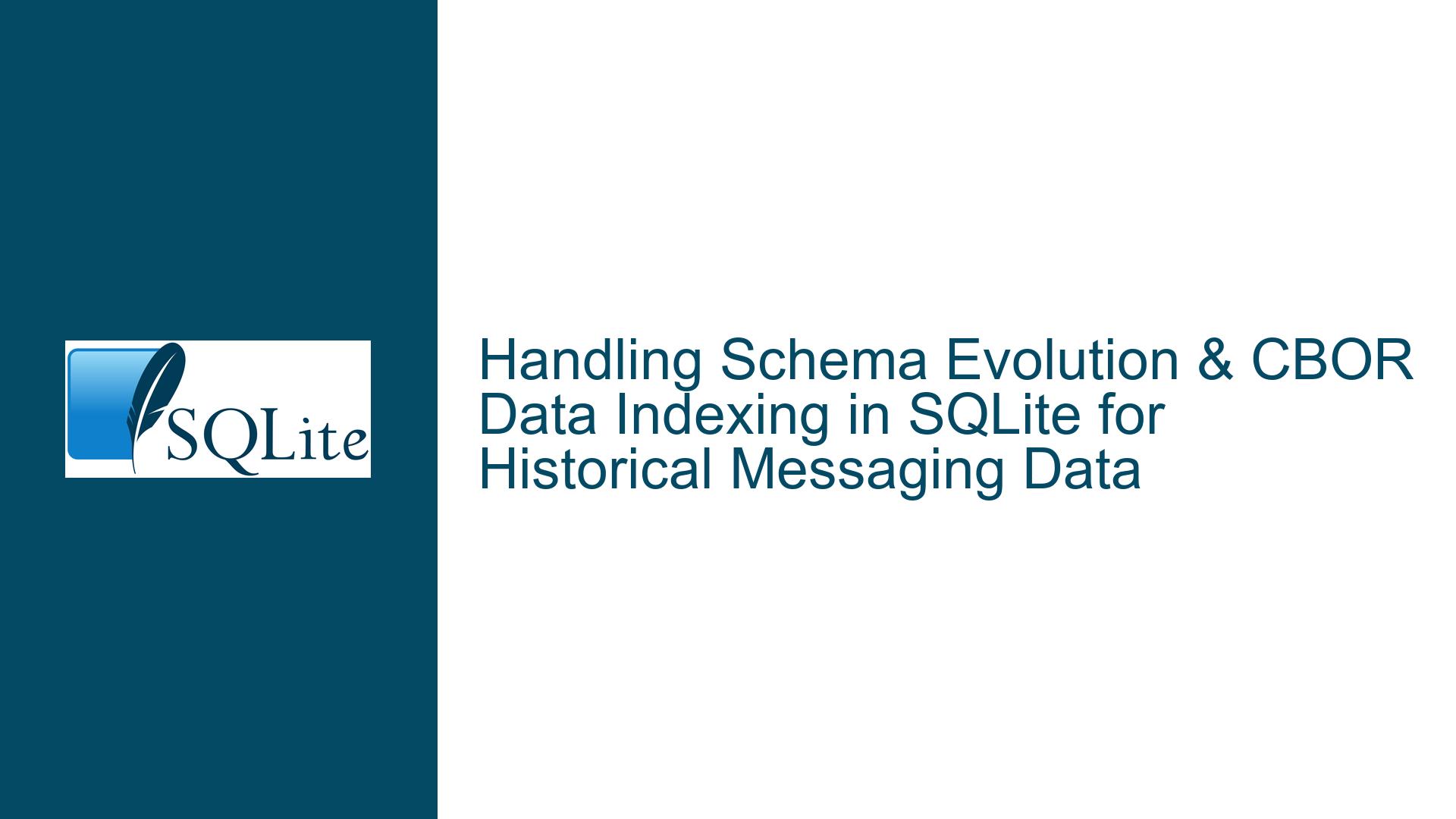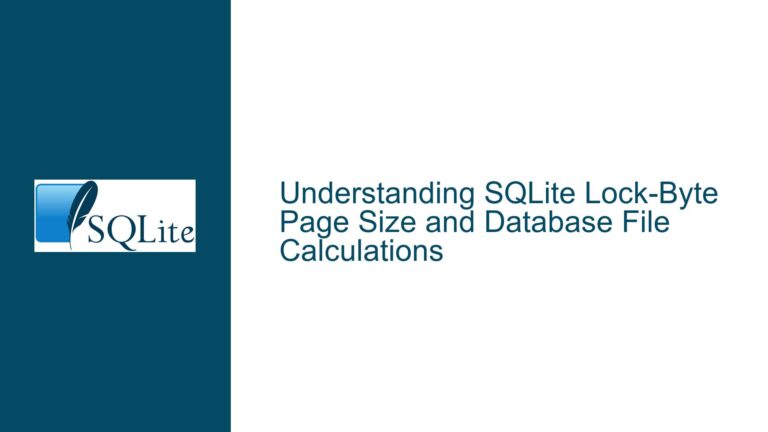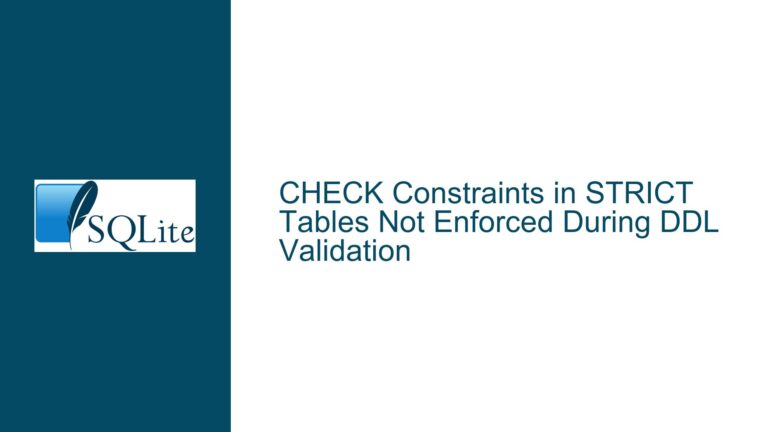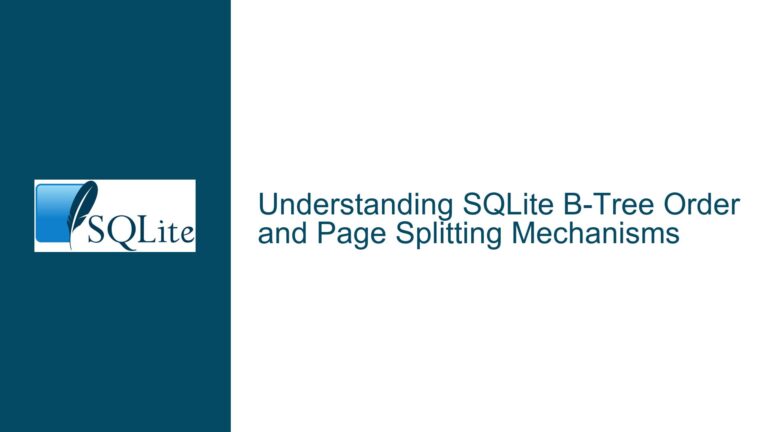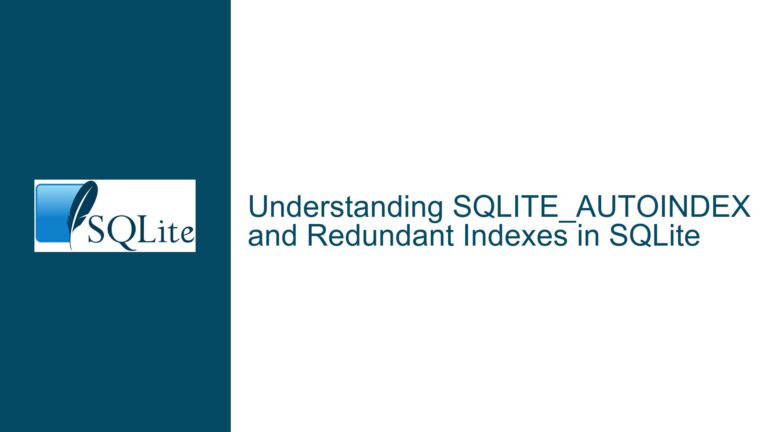Handling Schema Evolution & CBOR Data Indexing in SQLite for Historical Messaging Data
Issue Overview: Managing Evolving Message Schemas & CBOR Integration Challenges
The core challenge involves designing an SQLite database that perpetually stores multi-protocol messaging data (e.g., Telegram, web forums) with three critical constraints:
- Schema Evolution: Message structures change frequently (e.g., new fields, type changes, nested hierarchies) due to API updates, requiring backward-compatible storage without manual schema migrations.
- CBOR Integration: Using Concise Binary Object Representation (CBOR) for compact storage of typed/binary data while enabling efficient querying via indexes on nested/extracted fields.
- Historical Versioning: Preserving all message edits and metadata changes (avatars, votes) with version-aware queries, akin to a version control system, while avoiding storage bloat.
Key Technical Constraints
- Indexing Limitations: SQLite’s lack of native CBOR support complicates indexing inner fields (e.g.,
message.author.access_hash). - Data Compression: CBOR’s string reference tags (25/256) reduce redundancy but require application-layer handling.
- Cross-Protocol Normalization: Storing shared entities (users, files) once across protocols/accounts while isolating sensitive per-account tokens (e.g., Telegram’s access hashes).
- Query Efficiency: Resolving hierarchical relationships (messages within chats/threads) recursively without CTE performance degradation at scale.
Root Causes: Why Schema Flexibility & Indexing Failures Occur
1. Schema Rigidity in Relational Models
Traditional SQL schemas enforce strict column definitions, making field additions/type changes costly. For example:
- Telegram’s introduction of "message comments" transforms a flat
messagestable into a hierarchy requiringparent_message_idor JSON/CBOR blobs. - A field like
reactionsevolving from an integer (count) to a struct{count: int, users: []}breaks column-based storage.
2. CBOR’s Type System Mismatch
CBOR’s extensible type tagging (e.g., dates, binary data) isn’t natively understood by SQLite, causing:
- Loss of Type Fidelity: Storing CBOR blobs as
BLOBwithout schema-aware extraction functions. - Indexing Blind Spots: Queries like
WHERE cbor_extract(message, '$.created_at') > '2023-01-01'can’t leverage indexes unless materialized.
3. Versioning Overhead
Storing every edit as a separate row/version leads to:
- Table Bloat: Exponential growth in
message_editsif tracking minor changes (typos). - Temporal Query Complexity: Resolving "show message as it appeared on 2022-05-01" requires JOINs across versioned tables.
4. Cross-Protocol Data Isolation
Centralizing entities like users across protocols introduces:
- Access Control Conflicts: Protocol-specific tokens (e.g.,
access_hash) must be isolated per account. - Normalization Pitfalls: Using
INNER JOINon sharedcontent_blobsrisks exposing data across unauthorized accounts.
Solutions: Schema Design Patterns, CBOR Functions & Index Optimization
Step 1: Hybrid Schema Design for Evolving Fields
A. Entity-Value-Timestamp Model
Store immutable core fields in traditional columns and dynamic fields in CBOR blobs with versioning:
CREATE TABLE messages (
id INTEGER PRIMARY KEY,
protocol_id INTEGER, -- e.g., Telegram=1, Fossil=2
chat_id INTEGER,
sender_id INTEGER,
created_at DATETIME,
current_cbor BLOB, -- Latest CBOR data
current_version INTEGER
);
CREATE TABLE message_versions (
message_id INTEGER,
version INTEGER,
edited_at DATETIME,
cbor_data BLOB,
PRIMARY KEY (message_id, version),
FOREIGN KEY (message_id) REFERENCES messages(id)
);
B. Schema Version Metadata
Track API versions to decode historical CBOR blobs:
CREATE TABLE protocol_versions (
protocol_id INTEGER,
version INTEGER,
schema_cbor BLOB, -- CBOR schema descriptor (e.g., field types)
valid_from DATETIME
);
C. Sharded Compression Dictionaries
Prepend frequent strings/structures to CBOR blobs using protocol-specific dictionaries:
CREATE TABLE cbor_dictionaries (
protocol_id INTEGER,
dictionary BLOB, -- Predefined strings/keys for zlib-like compression
PRIMARY KEY (protocol_id)
);
Application code decompresses blobs by merging dictionary with cbor_data.
Step 2: CBOR Function Integration & Indexing
A. Custom CBOR Functions
Register SQL functions to extract CBOR fields deterministically:
// SQLite C API example
sqlite3_create_function(db, "cbor_extract", 2,
SQLITE_UTF8 | SQLITE_DETERMINISTIC, NULL,
cbor_extract_func, NULL, NULL);
void cbor_extract_func(
sqlite3_context *ctx,
int argc,
sqlite3_value **argv
) {
const uint8_t *cbor = sqlite3_value_blob(argv[0]);
const char *path = sqlite3_value_text(argv[1]);
// ... parse CBOR and return value as JSON/text ...
sqlite3_result_text(ctx, result, -1, SQLITE_TRANSIENT);
}
B. Expression Indexes on CBOR Paths
Create indexes on extracted fields for common queries:
CREATE INDEX idx_message_author ON messages (
cbor_extract(current_cbor, '$.author.id')
);
CREATE INDEX idx_message_date ON messages (
json_extract(cbor_to_json(current_cbor), '$.created_at')
); -- If CBOR->JSON conversion is needed
C. Shadow Tables for Advanced Indexing
For nested CBOR arrays/objects, use virtual tables to maintain inverted indexes:
-- Virtual table module for CBOR indexing
CREATE VIRTUAL TABLE cbor_message_fields USING cbor_shadow (
message_id INTEGER,
path TEXT,
value TEXT
);
-- Query plan using shadow table
SELECT m.* FROM messages m
JOIN cbor_message_fields f ON m.id = f.message_id
WHERE f.path = '$.tags' AND f.value = 'urgent';
Step 3: Versioning & Temporal Query Optimization
A. Efficient Version Storage
Use delta encoding for edits to minimize storage:
CREATE TABLE message_version_deltas (
message_id INTEGER,
base_version INTEGER,
delta_cbor BLOB, -- CBOR patch (RFC 7049 Appendix G)
PRIMARY KEY (message_id, base_version)
);
Reconstruct versions by applying delta_cbor to base_version’s CBOR.
B. Temporal Queries with Window Functions
Resolve the state of a message at a specific time:
SELECT
m.id,
LAST_VALUE(v.cbor_data) OVER (
PARTITION BY m.id
ORDER BY v.edited_at
RANGE BETWEEN UNBOUNDED PRECEDING AND '2022-05-01' PRECEDING
) AS historical_cbor
FROM messages m
JOIN message_versions v ON m.id = v.message_id;
C. Partitioning by Time
Attach historical data to separate databases by year/month:
ATTACH DATABASE 'messages_2022.db' AS hist_2022;
SELECT * FROM hist_2022.messages WHERE ...;
Step 4: Security & Cross-Protocol Isolation
A. Column-Level Encryption
Isolate sensitive fields using SQLite’s sqlcipher extension:
CREATE TABLE message_secrets (
message_id INTEGER,
access_hash BLOB ENCRYPTED (algorithm=AES256, key='...'),
FOREIGN KEY (message_id) REFERENCES messages(id)
);
B. Row-Level Access Views
Restrict protocol/account access via views:
CREATE VIEW telegram_messages AS
SELECT m.*, s.access_hash
FROM messages m
JOIN message_secrets s ON m.id = s.message_id
WHERE m.protocol_id = 1 -- Telegram
AND s.access_hash = (SELECT current_access_hash FROM user_session);
Step 5: Performance Tuning & Maintenance
A. In-Memory Caching of Frequent CBOR Paths
Use MEMORY tables for hot extracted fields:
CREATE TEMP TABLE cached_message_authors (
message_id INTEGER,
author_id INTEGER,
PRIMARY KEY (message_id)
) WITHOUT ROWID;
B. Analyze CBOR Access Patterns
Optimize indexes using SQLite’s sqlite_stat1 statistics:
ANALYZE cbor_message_fields;
UPDATE sqlite_stat1 SET stat = '10000 500' WHERE idx = 'idx_cbor_field_value';
C. Vacuum & Page Size Tuning
Configure SQLite for large blobs:
PRAGMA page_size = 8192; -- Larger pages for CBOR blobs
VACUUM; -- Rebuild DB after major deletions
By combining hybrid schema design, deterministic CBOR functions, and SQLite’s extensibility, developers can achieve schema flexibility, efficient indexing, and secure multi-protocol data isolation. This approach balances relational integrity with document-storage agility, ensuring historical data remains queryable despite API evolution.
